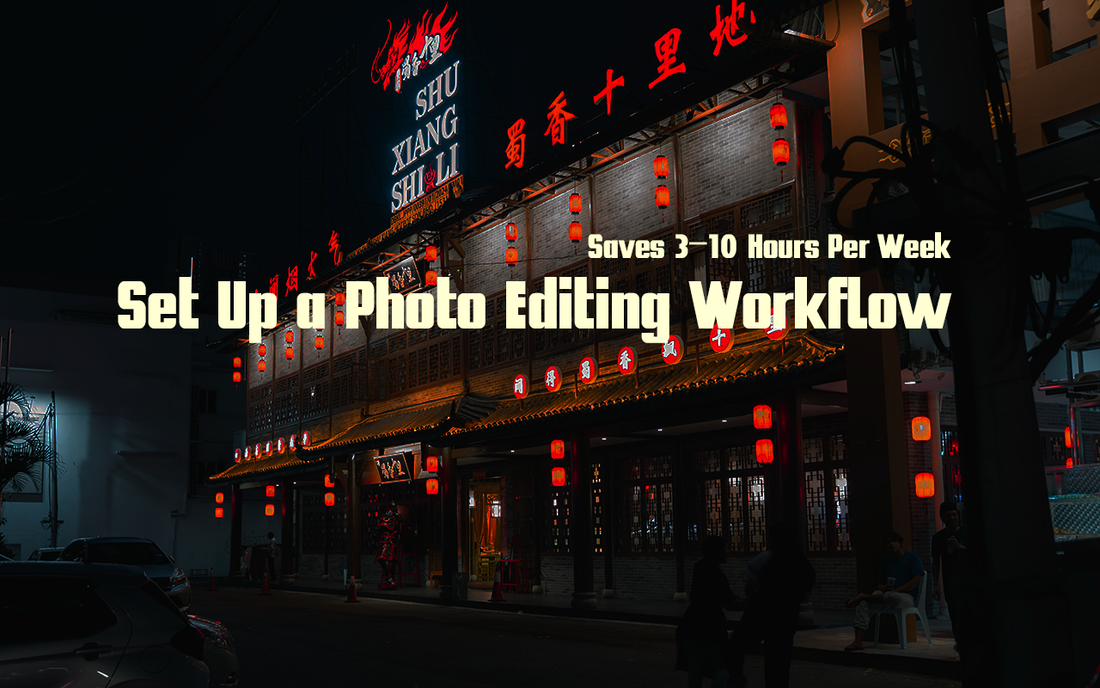
How to Set Up a Photo Editing Workflow That Saves 3–10 Hours Per Week
Share
In today’s fast-paced creative world, time is one of the most valuable resources photographers have. Between capturing stunning shots, editing, client communication, and marketing, your hours can easily disappear. The good news? By setting up an efficient photo editing workflow, you can save anywhere from 3–10 hours per week—time you can reinvest in shooting more, building your brand, or simply enjoying life.
This guide will walk you through the process step by step, using Lightroom as the foundation of your workflow. Along the way, we’ll cover powerful tools like Lightroom presets, batch editing, and smart file management. By the end, you’ll not only understand how to speed up your editing but also how to get consistent, professional-quality results.
Why a Workflow Matters for Photographers
Think of your workflow as a roadmap—it prevents you from wandering aimlessly and ensures you get from start to finish efficiently. Without a clear process, you risk:
-
Wasting hours digging through folders
-
Repeating the same edits over and over
-
Delivering inconsistent results to clients
-
Feeling stressed instead of creative
With a streamlined system, you’ll:
-
Save significant editing time
-
Deliver consistent, polished photos
-
Create more space for creativity
-
Increase client satisfaction
Step 1: Organize Your Files Like a Pro
The first step in saving time is reducing chaos. A well-organized file structure means you spend less time searching and more time editing.
Tips for organization:
-
Use a consistent folder naming system (e.g.,
2025_09_Wedding_Smith) -
Separate RAW files from exports
-
Back up to an external drive or cloud service
Bonus Tip: Automate file import settings in Lightroom so your images are neatly categorized from the start.
Step 2: Use Import Presets in Lightroom
When importing, you can save time by applying import presets. These allow you to apply basic adjustments, lens corrections, and metadata tags automatically.
-
Apply camera/lens corrections
-
Add your copyright info
-
Apply a base preset for consistency
This way, every image starts with a strong foundation, reducing the time you spend on individual tweaks later.
Step 3: Harness the Power of Lightroom Presets
One of the biggest time-savers in photo editing is Lightroom presets. Instead of manually adjusting exposure, contrast, tone curves, and colors every time, you can apply a preset and instantly transform your photo.
Why use presets?
-
Consistency: Create a signature style across your portfolio
-
Speed: Edit hundreds of photos in minutes
-
Professional results: Use expertly designed presets as a starting point
👉 If you’re curious, you can explore my premium Lightroom preset packs—crafted to save you hours while giving your photos a unique, cinematic look.
Step 4: Batch Editing – Edit Once, Apply to Many
Batch editing is where the real time savings kick in. Once you’ve dialed in your edit for one image:
-
Select all similar shots in Lightroom
-
Sync your settings across them
-
Make minor adjustments as needed
This is especially powerful for weddings, portraits, or travel photography, where lighting conditions often remain consistent within a series.
Step 5: Create Custom Shortcuts and Workspaces
Every second counts. By creating custom shortcuts and panel setups, you can eliminate wasted clicks.
-
Assign keyboard shortcuts to your most-used tools
-
Hide unused panels in Lightroom
-
Save custom workspaces tailored to your editing style
Step 6: Export Presets for Faster Delivery
Don’t waste time re-entering export settings every time. Set up export presets for:
-
Social media (optimized for Instagram, Facebook, TikTok)
-
High-res prints
-
Web use (smaller, faster-loading images)
Click once, and Lightroom does the rest.
Free vs Paid Presets: Which Should You Use?
A common question photographers ask is: Are paid presets worth it?
-
Free presets: Great for beginners but often limited in quality and flexibility.
-
Paid presets: Professionally designed, versatile, and built for consistent results across various lighting conditions.
If you’re serious about your photography, investing in premium presets can dramatically speed up your workflow and elevate your results.
FAQs About Lightroom Workflows
Q: How much time can I really save with presets and batch editing?
A: Most photographers report saving between 3–10 hours per week, depending on their workload.
Q: Do presets make my work look less original?
A: Not at all! Presets are starting points—you can always fine-tune them to match your unique style.
Q: Can I use the same workflow for client and personal projects?
A: Yes, having a consistent system works across all photography types.
Conclusion: Save Time, Create More
A well-structured photo editing workflow is not about cutting corners—it’s about working smarter so you can focus on what you love most: creating. By organizing your files, leveraging presets, and using batch editing, you’ll not only save hours each week but also produce stunning, consistent results.
If you’re ready to take your editing to the next level, check out my premium Lightroom presets. They’re designed to give you professional results instantly and help you reclaim your most valuable resource: time.
👉 [Explore My Preset Packs Here]
-
ightroom workflow
-
Editing faster in Lightroom
-
Photography tips for beginners
-
Best Lightroom presets 2025
-
Free vs paid presets
-
How to edit photos in Lightroom
-
Photo editing workflow
-
Lightroom Classic tips